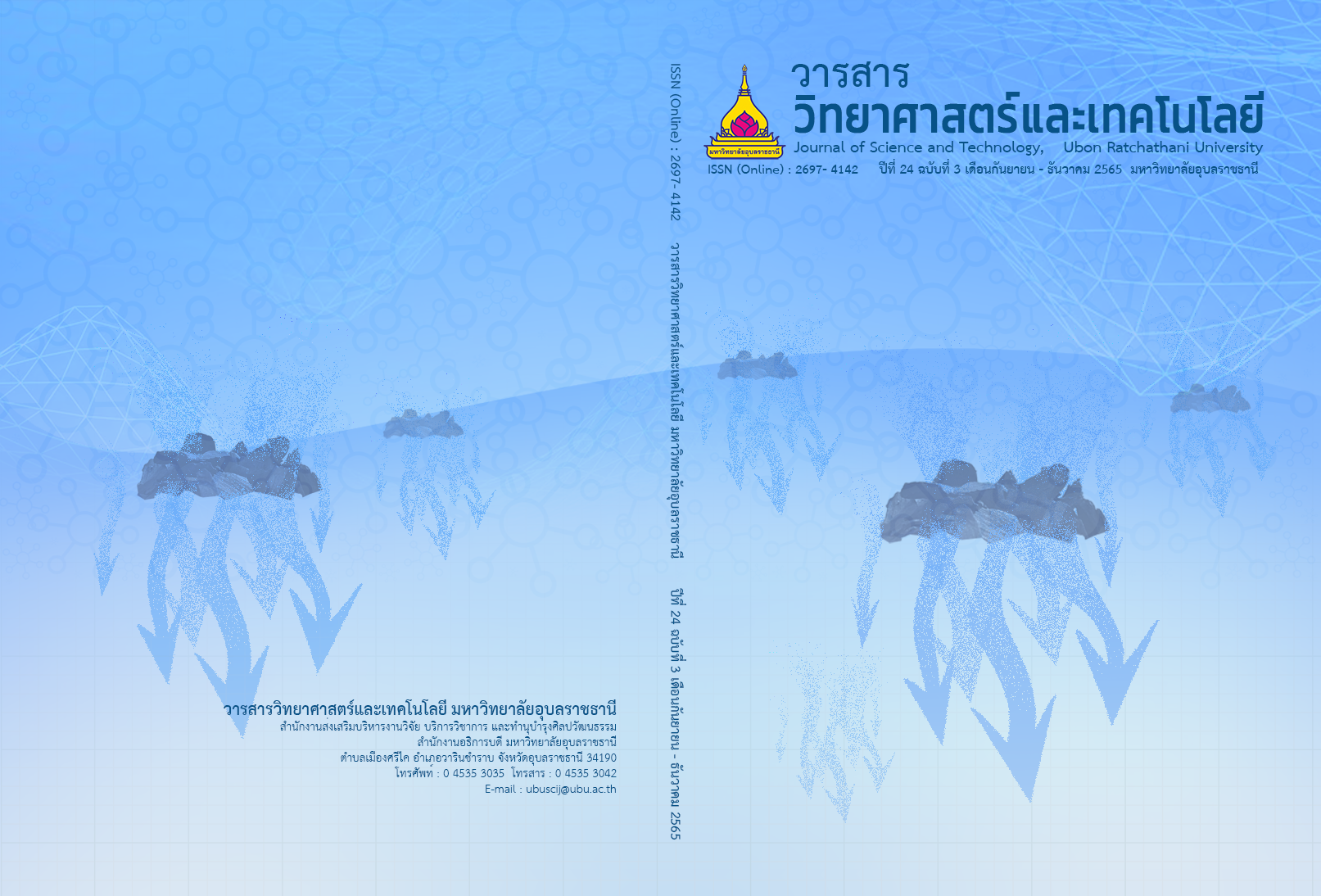โครงสร้างประชาคมปลาน้ำจืดในแม่น้ำชีตามประเภทการกินอาหาร: แนวโน้มและความผันแปร
Main Article Content
บทคัดย่อ
งานวิจัยนี้ได้ทำการศึกษาโครงสร้างประชาคมปลาในแม่น้ำชีโดยการแบ่งตามประเภทการกินอาหาร เพื่อเปรียบเทียบและดูแนวโน้มการเปลี่ยนแปลงในโครงสร้างประชาคมปลาในแม่น้ำชีโดยอาศัยดัชนีต่าง ๆ ที่เกี่ยวข้องกับระดับการกินอาหาร โดยใช้ข้อมูลผลจับต่อหน่วยลงแรงประมงในแม่น้ำชี ที่เก็บรวบรวมระหว่าง พ.ศ.2551 - 2563 ผลการศึกษาพบปลาในแม่น้ำชีอย่างน้อย 171 ชนิด โดยปลาส่วนมากที่สำรวจพบเป็นปลาในวงศ์ตะเพียนซิวสร้อย (Cyprinidae) ผลการจับปลาต่อหน่วยการลงแรงประมงมีค่าเฉลี่ยเท่ากับ 1.03 ± 0.20 กิโลกรัมต่อวัน ค่าความหลากชนิดเฉลี่ยเท่ากับ 17 ± 2 ชนิด ระดับการกินอาหารของปลาในประชาคมมีค่าเฉลี่ยเท่ากับ 2.88 ± 0.09 และ ค่าอัตราส่วนปลากินพืชหรือปลาเหยื่อต่อปลากินเนื้อมีค่าเท่ากับ 3.25:1 ในส่วนความผันแปรของผลการจับปลาต่อหน่วยการลงแรงในระยะยาวมีค่าระหว่างร้อยละ 62 - 72 ความผันแปรในระยะสั้นรูปแบบระยะสั้นที่แท้จริงและแบบสัมพัทธ์มีค่าระหว่างร้อยละ 60 - 73 และ ร้อยละ 67 - 76 ตามลำดับ จากผลการศึกษาสรุปได้ว่าโครงสร้างประชาคมปลาในแม่น้ำชียังอยู่
ในระดับที่สมดุลในเชิงโครงสร้างประเภทการกินอาหาร หากแต่มีแนวโน้มความผันแปรค่อนข้างสูง ซึ่งควรนำไปเป็นข้อพิจารณาในการวางแผนการจัดการทรัพยากรปลาในแม่น้ำชีต่อไป
Article Details

อนุญาตภายใต้เงื่อนไข Creative Commons Attribution-NonCommercial-NoDerivatives 4.0 International License.
บทความที่ได้รับการตีพิมพ์เป็นลิขสิทธิ์ของ วารสารวิทยาศาสตร์และเทคโนโลยี มหาวิทยาลัยอุบลราชธานี
ข้อความที่ปรากฏในบทความแต่ละเรื่องในวารสารวิชาการเล่มนี้เป็นความคิดเห็นส่วนตัวของผู้เขียนแต่ละท่านไม่เกี่ยวข้องกับมหาวิทยาลัยอุบลราชธานี และคณาจารย์ท่านอื่นๆในมหาวิทยาลัยฯ แต่อย่างใด ความรับผิดชอบองค์ประกอบทั้งหมดของบทความแต่ละเรื่องเป็นของผู้เขียนแต่ละท่าน หากมีความผิดพลาดใดๆ ผู้เขียนแต่ละท่านจะรับผิดชอบบทความของตนเองแต่ผู้เดียว
เอกสารอ้างอิง
Ratanalertnusorn, S. 2007. Principles of Conservation and Biological Management. Bangkok: Fine Print. (in Thai)
Office of National Water Resources Region. 2021. Watershed Information No.04 Chi River Basin. http://onwr3.onwr.go.th/?page_id=419. Accessed 1 March 2022. (in Thai)
Vidthayanon, C. 2017. Checklist of Freshwater Fishes in Thailand. Bangkok: Office of Natural Resources and Environment Policy and Planning. (in Thai)
Fisheries Development Policy and Planning Division. 2018. Fisheries Statistics of Thailand 2018. https://www4.fisheries.go.th/local/file_doc ument/20210129094223_new.pdf. Accessed 1 March 2022. (in Thai)
Behrenfeld, M.J. 2014. Climate-mediated dance of the plankton. Nature Climate Change. 4(10): 880-887.
Pauly, D. and et al. 1998. Fishing down marine food webs. Science. 279: 860-863.
Zhang, M. and et al. 2012. Trophic level changes of fishery catches in Lake Chaohu, Anhui Province, China: Trends and causes. Fisheries Research. (131-133): 15-20.
Shin, Y.J. and et al. 2005. Using size-based indicators to evaluate the ecosystem effects of fishing. ICES Journal of Marine Science. 62(3): 384-396.
Jutagate, T. and et al. 2012. Variations, trends and patterns of fish landings in large tropical reservoirs. Lakes & Reservoirs: Research and Management. 17(1): 35-53.
Vidthayanon, C., Karnasuta, J. and Nabhitabhata, J. 1997. Diversity of Freshwater Fish in Thailand. Bangkok: Office of Environmental Policy and Planning. (in Thai)
Vidthayanon, C. 2008. Field Guide to Fishes of the Mekong Delta. Vientiane: Mekong River Commission.
Phanitwong, N. 2020. Thai freshwater fish. Bangkok: P̣arbpim Printing. (in Thai)
Froese, R. and Pauly, D. 2022. FishBase. http:// www.fishbase.org. Accessed 20 February 2022.
Swingle, H.S. 1950. Relationships and Dynamics of Balanced and Unbalanced Fish Populations. Alabama: Agricultural Experiment Station of the Alabama Polytechnic Institute.
Funchess, M.J. 1950. Relationships and Dynamics of Balanced and Unbalanced Fish Populations Bulletin No.274. Alabama: Agricultural Experiment Station of the Alabama Polytechnic Institute.
R Core Team. 2019. R: A Language and Environment for Statistical Computing.R Foundation for Statistical Computing. https://www.R-project.org/. Accessed 1 March 2022.
Buijse, A.D., van Densen, W.L.T. and Machiels, M.A.M. 1991. Characteristics in the annual variation of yield from professional fisheries in freshwater bodies of the temperate and the tropical zones. In: Cowx, I.G. (ed.) Catch and Effort Sampling Strategies their Applications in Freshwater Fisheries Management. London: Fishing News Books.
Quinn, J.W. and Kwak, T.J. 2011. Fish assemblage changes in an Ozark River after impoundment: A long-term perspective. Transaction of the American Fisheries Society. 132: 110-119.
Dudgeon, D. 2011. Asian river fishes in the Anthropocene: Threats and conservation challenges in an era of rapid environmental change. Journal of Fish Biology. 79(6): 1487-1524.
Kasamesiri, P. and Thaimuangphol, W. 2020. Microplastics ingestion by freshwater fish in the Chi River, Thailand. International Journal of GEOMATE. 18(67): 114-119.
Seanghong, S. and et al. 2021. Fish diversity, habitat preference and assemblage patterns during the dry season in the upper Petchaburi River, Thailand. Journal of Fisheries and Environment. 45(3): 100-111.
Rainboth, W.J. 1996. Fishes of the Cambodian Mekong. Rome: FAO Species Identification Field Guide for Fishery Purposes.
Penczak, T. 2007. Can velocity affect growth and fecundity of facultative riverine fish species? Polish Journal of Ecology. 55(2): 357-366.
Jutagate, T. and et al. 2005. Changes in the fish catches during a trail opening of sluice gates on a run-of-the river reservoir in Thailand. Fisheries Management and Ecology. 12(1): 57-62.
Jutagate, T., Thappanand, T. and Tabthipwan, P. 2007. Is sluice gate management beneficial for spawning migrations? The case of the shark catfish (Helicophagus waandersii) in the Mun River below the Pak Mun Dam, Thailand. River Research and Applications. 23(1): 87-97.
Hydro and Agro Informatics Institute (Public Organization). 2012. Data Collection and Analysis Operations. Project to Develop a Data Warehouse System for 25 Watersheds and a Model for Flooding and Drought. https://tiwrm.hii.or.th/web/attachments/25basins/04-chi.pdf. Accessed 20 February 2022. (in Thai)
Pauly, D. and Palomares, M.L. 2005. Fishing down marine food webs it is far more pervasive than we thought. Bulletin of Marine Science. 76(2): 197-211.
Ngor, P.B. and et al. 2019. Maintaining perspective of ongoing environmental change in the Mekong floodplains. Environmental Sustainability. 8(8947): 1-12.


